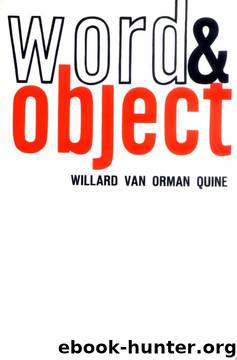Word and Object (Studies in Communication) by Willard van Orman Quine

Author:Willard van Orman Quine [Quine, Willard van Orman]
Language: eng
Format: epub
Published: 2009-11-24T14:12:00+00:00
(4) Tom believes that p.
But `p' represented any true sentence. Repeating the argument using the falsehood `Tully did not denounce Catiline' instead of the truth `Cicero denounced Catiline', we establish (4) also where `p' represents any falsehood. Tom ends up believing everything.'
Thus in declaring belief invariably transparent for the sake of (2) and `There is someone whom I believe to be a spy', we would let in too much. It can sometimes best suit us to affirm `Tom believes that Cicero denounced Catiline' and still deny `Tom believes that Tully denounced Catiline', at the cost-on that occasion-of (2). In general what is wanted is not a doctrine of transparency or opacity of belief, but a way of indicating, selectively and changeably, just. what positions in the contained sentence are to shine through as referential on any particular occasion.
A way of doing that is to agree to localize the failure of transparency regularly in the `that' of `believes that' and the `to' of `believes to', and not in the `believes'. Thus we may continue to write `Tom believes that Cicero denounced Catiline' when we are content to leave the occurrences of `Cicero' and `Catiline' nonreferential, but write rather:
Download
This site does not store any files on its server. We only index and link to content provided by other sites. Please contact the content providers to delete copyright contents if any and email us, we'll remove relevant links or contents immediately.
Cecilia; Or, Memoirs of an Heiress — Volume 1 by Fanny Burney(31327)
Cecilia; Or, Memoirs of an Heiress — Volume 3 by Fanny Burney(30929)
Cecilia; Or, Memoirs of an Heiress — Volume 2 by Fanny Burney(30886)
The Lost Art of Listening by Michael P. Nichols(6465)
We Need to Talk by Celeste Headlee(4863)
Asking the Right Questions: A Guide to Critical Thinking by M. Neil Browne & Stuart M. Keeley(4567)
On Writing A Memoir of the Craft by Stephen King(4206)
Dialogue by Robert McKee(3577)
I Have Something to Say: Mastering the Art of Public Speaking in an Age of Disconnection by John Bowe(3513)
Pre-Suasion: A Revolutionary Way to Influence and Persuade by Robert Cialdini(3404)
Elements of Style 2017 by Richard De A'Morelli(2940)
The Book of Human Emotions by Tiffany Watt Smith(2767)
Good Humor, Bad Taste: A Sociology of the Joke by Kuipers Giselinde(2555)
Name Book, The: Over 10,000 Names--Their Meanings, Origins, and Spiritual Significance by Astoria Dorothy(2488)
Fluent Forever: How to Learn Any Language Fast and Never Forget It by Gabriel Wyner(2442)
The Grammaring Guide to English Grammar with Exercises by Péter Simon(2391)
Why I Write by George Orwell(2356)
The Art Of Deception by Kevin Mitnick(2295)
Don't Sleep, There Are Snakes by Daniel L. Everett(2213)
